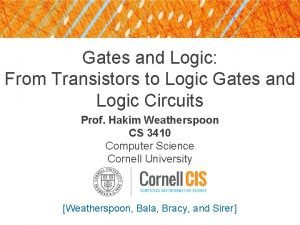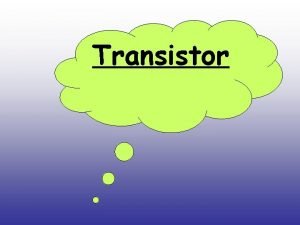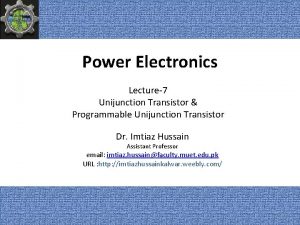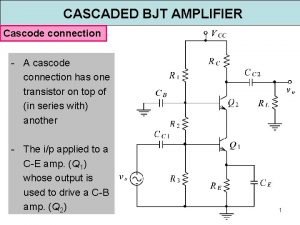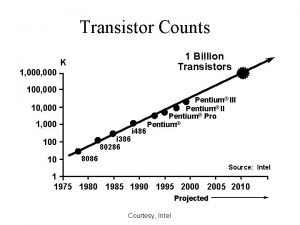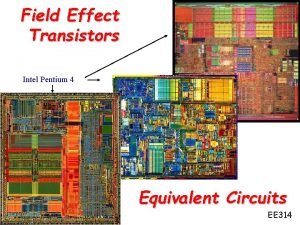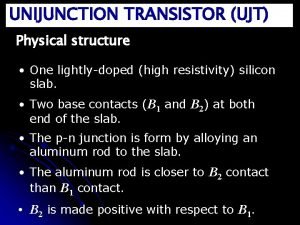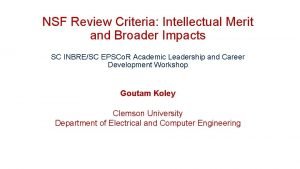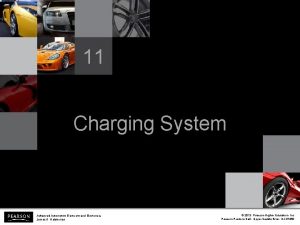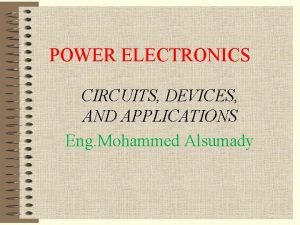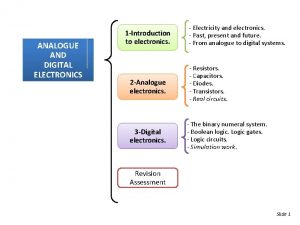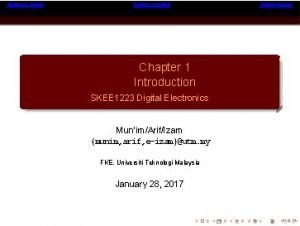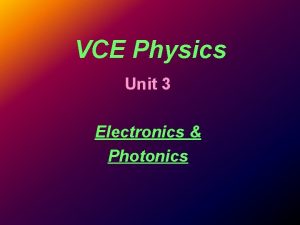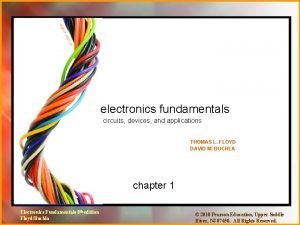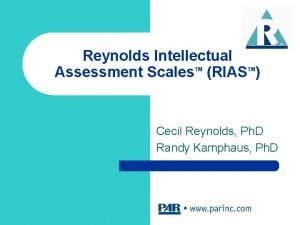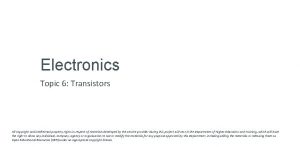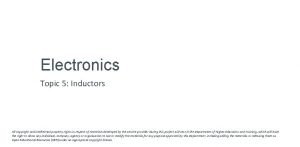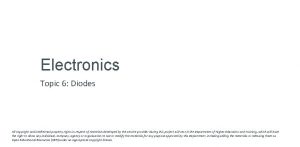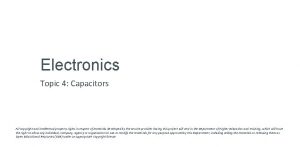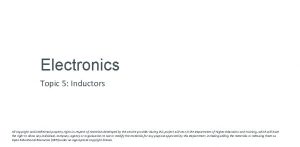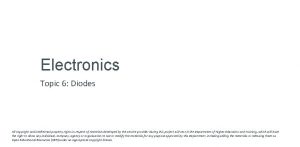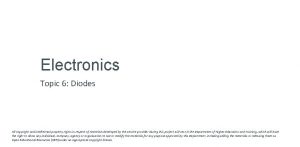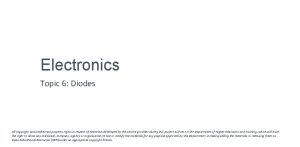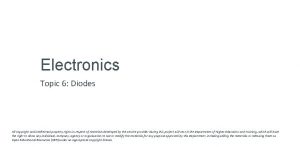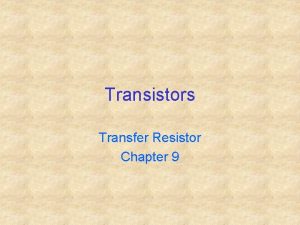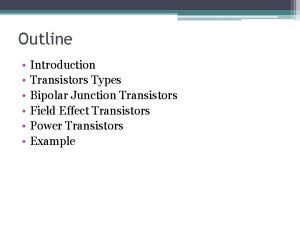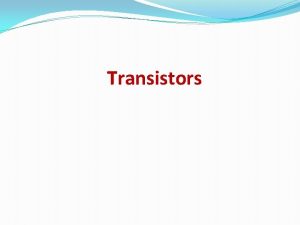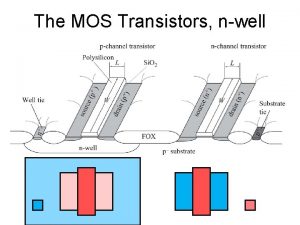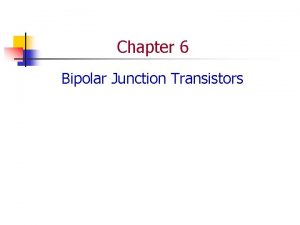Electronics Topic 6 Transistors All copyright and intellectual


























































- Slides: 58

Electronics Topic 6: Transistors All copyright and intellectual property rights in respect of materials developed by the service provider during this project will vest in the Department of Higher Education and Training, which will have the right to allow any individual, company, agency or organisation to use or modify the materials for any purpose approved by this Department, including selling the materials or releasing them as Open Educational Resources (OER) under an appropriate copyright license.

Assumed prior learning 05_01_00 05_01_02 05_02_01 05_03_01 05_04_01

Outcomes By the end of this unit the learner will be able to: 1. Explain what transistors are and how they work 2. State what is meant by ”transistor action”

Unit 7. 1: An Introduction to Transistors

Introduction Finally, we arrive at the king of electronics components – the transistor! In many ways, the story of the 20 th Century was the story of the transistor and few inventions have revolutionised the world quite as much. Transistors are at the heart of modern life and make up the brains of most of the electronic stuff we use every day.

The invention that changed the world Like diodes, transistors are semiconductors, made from P and N type semi-conductor materials. But it is how these materials are arranged that give transistors their “magical” properties. Before we go on, let’s take a quick detour to learn more about how these tiny little devices have literally changed the world. YT 01

The transistor OK. Change the world. Check! Time to start getting to know these amazing little guys. Watch the video to see a brief introduction to transistors and their history. YT 02

Build the Circuit As usual, the best way to find what a component does, is to play with it. Here is the simple circuit you need to build. Build this circuit. Rollover or touch each symbol in the schematic to find out more. Watch the video if you need help. Watch how to build the circuit

Take a picture of your completed circuit and upload it to your online portfolio. . Choose image Upload

Review How To Use a Multimeter We now need to take some readings from our circuit and do some calculations. Refer to the multimeter guide saved on your device or click the image to see it again. Img 02

Step 1 Before you connect the battery, do you expect the LED to come on in this circuit? Why or why not? Set your multimeter to read m. A and connect the battery. Take a reading of the current flowing through the LED. What is the current? Current: Check m. A Img 03

Step 2 Measure the current through the 50 kΩ resistor. Img 04 Current: Check m. A

Step 3 Close the switch and observe what happens. Measure the current through the LED now. What do you think is happening in the circuit to make the LED shine now? Current: Check m. A Img 05

Step 4 Measure the current through the 50 kΩ resistor. What is the relationship between this current and that through the LED? Note, you may need to set your multimeter to read μA to get an accurate reading. Current: LED current is Check m. A X 50 kΩ resistor current Img 06

An electronic switch In the experiment, we saw that the transistor behaved like a switch. As soon as we allowed current to flow through the 50 kΩ resistor and transistor, a current about 100 times larger flowed through the LED part of the circuit. This is called transistor action. Watch the video to see this switch in action. Vid 02

A night light This simple circuit shows just how useful transistors can be. It is very similar to the previous one we built. Build this circuit. Rollover or touch each symbol in the schematic to find out more. Watch the video if you need help. Watch how to build the circuit

Take a picture of your completed circuit and upload it to your online portfolio. . Choose image Upload

Step 1 If the photo resistor has a higher resistance in the dark, when do you think the LED will come on? Place your circuit is bright light. Does the LED come on? o Yes o No Check Img 03

Step 2 Now place your circuit is the dark or cover the photoresistor with some tape or your hand. Does the LED come on? Img 04 o Yes o No Check

A night light Well done! You just created a working night light. The light only comes on in the dark. But is this an efficient design? Watch the video to check your understanding of how this circuit works. Vid 04

Semi-conductor review So far, we have discovered that transistors behave like little electrical switches. But how exactly do they work? In order to under this, we need to first brush up on what we know about semiconductors. Watch these video to review what we know about semi-conductors. YT 03 YT 04

Semi-conductor sandwiches We know that diodes are made up of P and N type semiconductor material stuck together. Well, transistors are like semiconductor sandwiches where we have either a NPN or PNP sandwich. Watch the video to learn how transistors work. YT 05

Bi-polar junction transistors The most common type of transistor that you are likely to come across is the bi-polar junction transistor or BJTs are used when the operating currents are small. There are 2 types of BJTs available. Click on the buttons to learn about each one. NPN PNP

NPN transistors are most common and are made by sandwiching P-type material between 2 layers of N-type material, hence the name NPN. Take note of the symbol and the names of the three leads. If we can get a small current from the base to the emitter, a large current will flow from the collector to the emitter. The arrow in the symbol shows convectional current flow. Never Points i. N Collector N Base P Base N Emitter

PNP transistors We can also make a PNP transistor. They are far less common than the NPN type. In this case a small current flowing from the emitter to the base results in a large current flowing from the emitter to the collector. Notice the different symbol used for PNP type transistors. The arrow shows conventional current flow. Points i. N Permanently Emitter P Base N P Collector

NPN vs PNP NPN and PNP transistors are opposites but things can get a little confusing, so let’s take a moment to make sure we understand the differences between NPN and PNP transistors and how they work. Watch the video for a detailed look at the differences between NPN and PNP transistors. YT 06

Build the Circuit We have mentioned before that transistors act as electronic switches and current amplifiers. Let’s explore these a bit more. Build this circuit. Rollover or touch each symbol in the schematic to find out more. Watch the video if you need help. Watch how to build the circuit

Take a picture of your completed circuit and upload it to your online portfolio. . Choose image Upload

Review How To Use a Multimeter We now need to take some readings from our circuit and do some calculations. Refer to the multimeter guide saved on your device or click the image to see it again. Img 02

Step 1 Before you connect the battery, make sure that the switch is open. With the switch open measure the voltage VCE (the voltage over the collector and emitter). VCE V Is the lamp on? Check Yes No Img 03

Step 2 Close the switch and adjust the potentiometer until the lamp is at full brightness. Measure the voltage VCE (the voltage over the collector and emitter) and the voltage over the lamp. VCE V Vlamp V Check Img 04

Step 3 Connect your multimeter across the collector and emitter and adjust the potentiometer until VCE is about 2 V, 5 V and 7 V. What happens to the lamp? VCE = 2 V: VCE = 5 V: VCE = 7 V: Check Img 05

Transistor modes The previous experiment demonstrated the 2 distinct ways in which a transistor can behave in a circuit which we call: 1. Switching mode and 2. Linear mode Watch the video to check your understanding of these modes. Vid 06

Linear and switching modes? Let’s formalize what we know about what transistors do in a circuit. Click on each button to read more. Switching mode: Transistors can act as current 1 controlled switches. Linear mode: Transistors can act as current 2 amplifiers.

Switching mode If current flows between the base and emitter, the transistor switches ON and allows a current to flow between the collector and emitter. This signal determines if the transistor is fully on or fully off. NPN Base must be at a higher voltage (at least 0. 6 V) than the emitter and current flows from base to emitter. + - PNP Base must be at a lower voltage (at least 0, 6 V) than the emitter and current flows from emitter to base. + -

Linear mode The current that flows between the collector and emitter is a multiple of the current that flows between the base and the emitter. This multiple is called the Beta and given the symbol HFE. For both NPN and PNP transistors. For linear mode operation, we just need to keep IB within certain parameters. IB, and therefore IC are gradually increased and decreased. IE IC IB IB IE IC IC + IB = IE

Virtual transistor action Let’s look at simulated circuits with both NPN and PNP transistors to confirm what we know about transistor action. Download and work through the worksheet. Then watch the video to make sure you completed everything correctly. Download the worksheet Vid 07

Test Yourself We have come to the end of this unit. Answer the following questions to make sure you understand the basics of transistors.

Question 1 Which symbol is for a NPN transistor? a) b)

Question 2 What are the names of the transistor leads. Choose all the correct answers. a) b) c) d) e) f) Base Emit Exit Collector Emitter Basic

Question 3 Drag the names to the correct places on the diagram. Base Collector Emitter Base

Question 4 Drag the correct voltage supply symbols onto this circuit so as to bias the transistor correctly.

Question 5 Which mode would a transistor be used in to amplify small changes in current? a) Linear mode b) Switching mode c) Amplification mode d) Magnification mode

Question 6 Drag the symbols to give the relationship between IE, IC and I B. IE IC IB + = IC + IB = IE IB + IC = IE

Question 7 Which image shows the correct current flow the circuit when the transistor is on? a) b) c) d)

Question 8 In the case of a NPN transistor which is on, which terminal of VBC is more positive? a) B b) C c) Both the same

Question 9 A NPN transistor has a beta value of 100. If IB is 0. 764 m. A, what can we expect IC to be? a) b) c) d) 0. 764 m. A 7, 64 m. A 764 m. A

Question 10 A PNP transistor as a beta value of 60. If IE is 142 m. A what is I B? a) b) c) d) 180 m. A 2 m. A 163μA 2. 33 m. A

Video Briefing – Vid 01 Create a video presented by an expert presenter showing step-by-step how to build the circuit on a breadboard. The presenter needs to explain the following: 1. How to connect the transistor correctly. The names of the pins (Collector, Base and Emitter) should be mentioned. Orientate the pins with regard to the flat edge of the casing.

Video Briefing – Vid 02 Create a video presented by an expert presenter showing and explaining the operation of the transistor in the experiment. 1. With the switch open and the battery disconnected, explain that we would expect the LED to light up 2. Connect the battery – LED does not light up even though it is connected in series with the battery. The transistor must somehow be blocking the current. Measure the LED current to confirm. 3. Measure 50 K resistor current to confirm that it is zero – what we expect as the switch is open. 4. Close the switch and observe LED come on. Measure the current through the LED and 50 K resistor. Establish that the LED current is about 100 times greater than the 50 K resistor current. 5. Explain that as soon as a little bit of current is allowed to enter the transistor through the middle pin (the base), a lot of current can flow through the transistor from the left pin (collector) to the right pin (the emitter) (L/R with respect to flat end of package). 6. Refer to http: //everycircuit. com/circuit/5578205225549824 for a simulation of the circuit.

Video Briefing – Vid 03 Create a video presented by an expert presenter showing step-by-step how to build the circuit on a breadboard. The presenter needs to explain the following: 1. How to connect the transistor correctly. The names of the pins (Collector, Base and Emitter) should be mentioned. Orientate the pins with regard to the flat edge of the casing. 2. How a photoresistor works – light = low resistance; dark = high resistance

Video Briefing – Vid 04 Create a video presented by an expert presenter showing and explaining the operation of the night light circuit. 1. Show the circuit in the light and explain why the LED is not on – Photoresistor resistance is low so current would rather flow through it than through the transistor. Transistor switch is closed. LED does not light up. 2. In the dark, resistance of photoresistor increases so current rather flows through the transistor. Transistor switch open and LED comes on. As soon as we get a current flowing from the base to the emitter, we get a much bigger current flowing from the collector to the emitter. This is transistor action 3. Using http: //everycircuit. com/circuit/6117730507030528 show the small current into the base of the transistor results in a large current from C to E – about 100 times. 4. Explain why the design is not very efficient. In the light there is still a leakage current that always flows draining the battery. It is a small current but still there. Again show that as I BE increases, ICE

Video Briefing – Vid 05 Create a video presented by an expert presenter showing step-by-step how to build the circuit on a breadboard. The presenter needs to explain the following: 1. How to connect the transistor correctly. The names of the pins (Collector, Base and Emitter) should be mentioned. Orientate the pins with regard to the flat edge of the casing.

Video Briefing – Vid 06 (1 of 2) Create a video presented by an expert presenter showing and explaining the operation of the transistor mode (linear and switching) demonstration circuit and working through each of the steps. Use http: //everycircuit. com/circuit/6089153510113280 to aid explanations. 1. With switch open, show that no current can flow between base and emitter and full supply voltage appears over the transistor like with an open switch. 2. Close the switch and explain that still no current is flowing form base to emitter so transistor is still behaving like a switch. Show VCE is still much the same as the supply voltage Adjust the potentiometer to get bulb at max brightness. Show now that V CE is small and most of the supply voltage is dropped over the bulb, hence the transistor is behaving like a closed switch. Measure IB and Ilamp at this point. IB should be quite small. Keep adjusting the potentiometer and show that the bulb gets no brighter (Ilamp does not increase) but IB keeps increasing. Therefore beyond a certain point, the transistor is on and no further changes occur in bulb brightness. All the additional current flows from base to emitter. Explain that this change from bulb = off to bulb = brightest shows

Video Briefing – Vid 06 (2 of 2) Now adjust the potentiometer to get VCE = 2 V, 5 V and 7 V. Show that the bulb starts to shine less brightly. Measure IB and Ilamp while making these changes to show that Ilamp is about IB x 100 i. e. in this range the transistor is acting as a current amplifier. We call this linear mode. Linear mode means that the transistor operates where IB and therefore IC is gradually increased and decreased, preventing IB being driven to the extremes of maximum m. A or zero m. A.

Document Briefing – Doc 01 (1 of 2) Create an annotated PDF worksheet with the following steps. • Make sure you have downloaded the Every. Circuit App from your app store. • If you are working on a computer, visit http: //everycircuit. com/app/. • Open the Every. Circuit app and signup. After your trial, you will still have access to Every. Circuit and other people’s circuits. You will just not be able to create your own circuits. • Go to the community space and search for the circuit called “NOC_Transistor Action” • There are 2 circuits. You should be able to tell which circuit contains an NPN transistor and which one contains a PNP transistor. Both circuits are powered by a 5 V DC power source. • In the left hand NPN circuit: • Is current flowing in the circuit • At what voltage is the base? • At what voltage is the emitter? • Is the base at a higher voltage than the emitter? • Is the voltage difference greater than about 0. 6 V? • In which direction is current flowing through the base? Does this make sense given the voltage difference between the base and emitter?

Document Briefing – Doc 01 (2 of 2) • • • In the right hand PNP circuit: • Is current flowing in the circuit? • At what voltage is the base? • At what voltage is the emitter? • Is the base at a lower voltage than the emitter? • Is the voltage difference greater than about 0. 6 V? • In which direction is current flowing through the base? Does this make sense given the voltage difference between the base and emitter? In both circuits, is the relationship between IE, IC and IB given by IE = IC + IB? In the left hand NPN circuit: • What are the values of IB and IC? • What is the transistor’s beta value (HFE)? In the right hand PNP circuit: • What are the values of IB and IC? • What is the transistor’s beta value (HFE)? What is the relationship between IC, IB and beta in both circuits?

Video Briefing – Vid 07 A screencast video presented by an expert electrician working through Doc 01. 1. Show in the NPN circuit the base is at a higher voltage than the emitter. As this difference is greater than 0. 6 V, current flows from Base to Emitter turning the transistor on and allowing current to flow from collector to emitter. 2. Show in the PNP circuit the emitter is at a higher voltage than the base. As this difference is greater than 0. 6 V, current flows from Emitter to base turning the transistor on and allowing current to flow from emitter to collector. 3. Show that in both circuits IE = IC + IB 4. Show that beta for the NPN transistor is 100 5. Show that beta for PNP transistor is 150 6. Show IC = beta x IB 7. Explain that beta is not a fixed value but changes with IC – show https: //www. jameco. com/Jameco/Products/Prod. DS/178597. pdf as an example (current gain
 Transistor or gate
Transistor or gate How pnp transistor works as a switch
How pnp transistor works as a switch Put transistor
Put transistor Application du transistor
Application du transistor Cascading transistor amplifier
Cascading transistor amplifier 1 billion transistors
1 billion transistors Graphical analysis
Graphical analysis Physical structure of ujt
Physical structure of ujt Mega giga tera
Mega giga tera Second generation of computer
Second generation of computer Interpretations of more’s law assert that
Interpretations of more’s law assert that Pee writing strategy
Pee writing strategy /topic/ down
/topic/ down Name
Name Copyright 2015 all rights reserved
Copyright 2015 all rights reserved Copyright © 2015 all rights reserved
Copyright © 2015 all rights reserved Dell all rights reserved copyright 2009
Dell all rights reserved copyright 2009 Copyright © 2018 all rights reserved
Copyright © 2018 all rights reserved The intellectual and spiritual leaders.
The intellectual and spiritual leaders. Chapter 50 intellectual and developmental disabilities
Chapter 50 intellectual and developmental disabilities Intellectual definition health and social care
Intellectual definition health and social care Dualism multiplicity and relativism
Dualism multiplicity and relativism Key intellectual movement of the renaissance
Key intellectual movement of the renaissance Intellectual merit
Intellectual merit What are the intellectual traits
What are the intellectual traits What is the climax of huckleberry finn
What is the climax of huckleberry finn John donne born
John donne born Setup time and hold time in digital electronics
Setup time and hold time in digital electronics Advanced automotive electricity and electronics
Advanced automotive electricity and electronics Electronics and telecommunications research institute
Electronics and telecommunications research institute Ministry of electronics and information technology
Ministry of electronics and information technology Latest electronics and information technology in odisha
Latest electronics and information technology in odisha Power electronics circuits devices and applications
Power electronics circuits devices and applications Multiplexer and demultiplexer in digital electronics
Multiplexer and demultiplexer in digital electronics Weighted and non weighted binary codes
Weighted and non weighted binary codes Analogue and digital electronics
Analogue and digital electronics Introduction to analog and digital electronics
Introduction to analog and digital electronics Current divider formula
Current divider formula Electronics fundamentals circuits devices and applications
Electronics fundamentals circuits devices and applications Memory in digital electronics
Memory in digital electronics Intellectual capital examples
Intellectual capital examples Lifang zhang
Lifang zhang Trade related aspects of intellectual property rights
Trade related aspects of intellectual property rights Reynolds intellectual assessment scales
Reynolds intellectual assessment scales Intellectual property rights in professional practices
Intellectual property rights in professional practices Intellectual development middle adulthood
Intellectual development middle adulthood Accommodations for borderline intellectual functioning
Accommodations for borderline intellectual functioning Ascending levels of intellectual demand
Ascending levels of intellectual demand Late adulthood mental development
Late adulthood mental development Importance of intellectual property
Importance of intellectual property Intellectual property management definition
Intellectual property management definition Advantages of intellectual property
Advantages of intellectual property Intellectual integrity meaning
Intellectual integrity meaning Meaning of intellectual freedom
Meaning of intellectual freedom Define intellectual curiosity
Define intellectual curiosity Intellectual property business plan
Intellectual property business plan Property
Property Early adulthood development stages
Early adulthood development stages Humanistic-aesthetic approach
Humanistic-aesthetic approach
